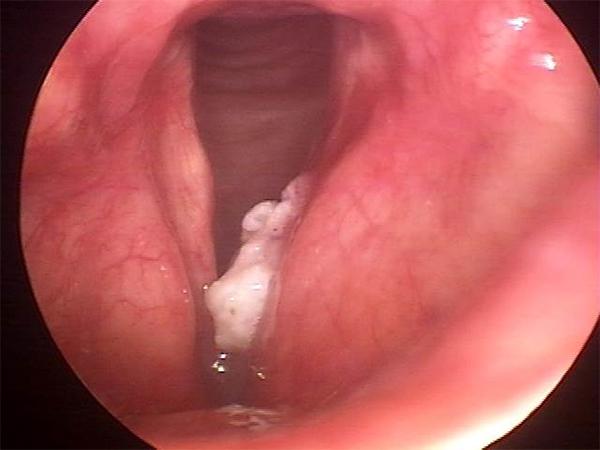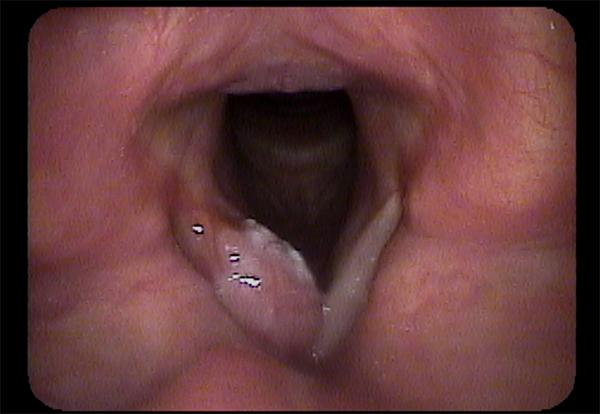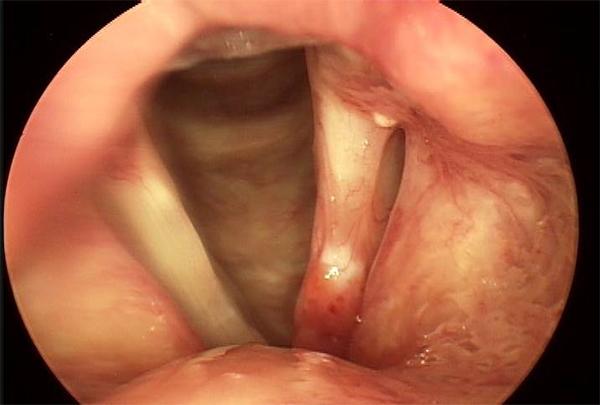Whether you see us in-person or by Video Visit, we're here for you. See how we're keeping you safe.
Laryngeal cancer, like other cancers, is a change of normal tissue to tissue that grows uncontrollably. Laryngeal cancer begins in the cells of the surface lining of the larynx. If unchecked, laryngeal cancer forms a tumor that spreads into deeper and neighboring spaces, first locally, then to lymph nodes in the neck and eventually to other parts of the body, usually the lungs. On occasion, laryngeal cancer may arise from an existing premalignant lesion, or dysplasia.
Smoking is responsible for the overwhelming majority of laryngeal cancers. The tissue changes and irritation from smoking are aggravated by the effects of alcohol, so that the effects of the two together are greater than each one separately. Laryngeal cancer in nonsmokers is rare.
Laryngeal cancer is highly curable provided it is diagnosed early, particularly before spread to the deep tissue of the larynx. Moreover, advances in the last decades have made cure possible without removal of the larynx in many cases. Prompt evaluation of hoarseness, especially in smokers, is the start of successful treatment.
Symptoms depend on the location of the cancer. If it grows on the vocal fold, cancer causes hoarseness, even when it is small. Most hoarseness, particularly in nonsmokers, is caused by benign lesions. Nevertheless, because effective cure depends on early diagnosis, hoarseness that lasts beyond two weeks should be brought to the attention of a doctor able to examine the vocal folds. Smokers are often hoarse for other reasons (for example Reinke’s edema or chronic laryngitis), which may result in postponing a visit to the doctor’s office and delaying diagnosis.
Cancers elsewhere in the larynx generally grow to a larger size before they cause symptoms, because these tissues are less involved in voice production. The first sign of such a cancer may be a bloody cough, or noisy or difficult breathing caused by the bulk of the tumor.
Laryngeal cancers generally have the appearance of sores or growths on the surface of the larynx. These may be white or red in appearance, and they vary in size and location. They may appear anywhere along the length of the vocal folds, as well as on other parts of the larynx. Unlike most benign lesions, cancers usually have a rough, irregular surface and may bleed from time to time.

The irregular white mass of the left vocal fold (right in the image) is a cancer.
Once it grows deep into the surface tissue, cancer of the vocal fold may affect the vibration of the mucosa. Stroboscopy can be very useful in assessing the integrity of the vibratory tissue, and a careful interpretation of the exam may help distinguish between a cancerous and a benign lesion. Ultimately, only an examination of a lesion specimen, or biopsy, under the microscope can yield a definite diagnosis. Therefore, lesions with suspicious features should undergo microlaryngoscopy or office biopsy.

The bulky rounded mass on the right vocal fold (left in the image) is an early vocal cord cancer.
The treatment options for laryngeal cancer are determined by location, size and extent. Laryngeal cancer may be treated by means of surgery, radiation, chemotherapy, or a combination of these. A detailed discussion of the various factors surrounding treatment choice is best carried out face-to-face with your physician. Generally, the treatment strategy will aim to cure the disease while maintaining the highest possible quality of life.
Often, there will be a choice among treatments. Your physician should be able to explain these in some detail, along with their advantages and disadvantages. It is reasonable to seek a second opinion in the treatment of cancer, as long as it does not unduly delay treatment.
Generally, small lesions confined to the larynx may be treated with surgery or radiation alone. The cure rates of each are equivalent. Radiation has yielded less immediate vocal disability than surgery, but causes irreversible changes in the normal tissue surrounding the tumor. Those changes may cause permanent symptoms such as hoarseness, difficulty swallowing or dryness of the throat. Surgery may result in greater hoarseness immediately after treatment, but voice recovery is often very good, and it does not carry the longterm tissue consequences of radiation. Surgical techniques have gained immense popularity in view of their high success rate and ease of recovery.

The red area at the front of the left vocal fold (right in the image) is an early cancer which is curable with limited surgery.
In larger tumors of the larynx, with or without invasion into the surrounding neck tissues, radiation is combined with chemotherapy, and sometimes followed by surgery to remove any disease which may be left. Minimally invasive or partial laryngectomy procedures may also be possible in select instances. Large, bulky tumors may still require surgical removal, or at least surgery to open an airway prior to any additional treatment.
Once laryngeal cancer has traveled out of the neck to remote organs, most commonly the lungs, it is generally much less likely to be curable. However, measures can be undertaken to reduce the burden of disease, slow down its progression and minimize its negative effects on quality of life.
More information is available from the National Cancer Institute.